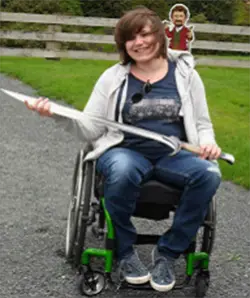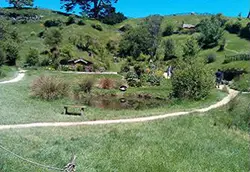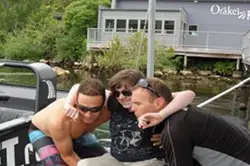Do you have a disability and want to travel to New Zealand? Read about the adventures of Jasmine, who has Friedreich’s Ataxia and has returned to share her experience. Find out how you too can travel to New Zealand.
My name is Jasmine, I’m 21 and I’m from Portsmouth, UK. In October 2010 I was diagnosed with Friedreich’s Ataxia, a neurodegenerative disease. As a side effect of the disease (I can’t walk at all) I have metal rods fixed in my spine to correct the scoliosis. My wheelchair is a Quicky Helium, it has a solid frame but the wheels are removable and the back folds flat down to the seat.
Despite the obvious challenges, I’ve always loved to travel and have just returned from the trip of a lifetime, spending three weeks exploring New Jersey’s North Island. As a huge Tolkien fan and environmental scientist, the trip was a dream come true for me.

Flying to New Zealand
We (me, my friend Julia and carer Steph) flew out of Heathrow on Air New Zealand flight NZ001, a direct flight to Auckland with only a two hour stop at Los Angeles International Airport. We chose this flight because we were told there was a disabled toilet on board the plane (a Boeing 777-300).
But it wasn’t a very good toilet. It was bigger than a normal airplane toilet, and there was space to put an aisle chair next to the toilet, but not much else. The grab bars were too small and not in the right place (I couldn’t reach them so the flight attendant had to lift me up to the toilet). And of course there was only a grab bar on one side. In the UK it’s law to have grab bars on both sides, but I don’t think that’s the case in other countries.
In addition to the bathroom issues, the aisles on the plane were also incredibly narrow, and although the aisle seats themselves were awful (incredibly narrow and felt unstable the entire time I was sitting in them), combined with the narrowness of the aisle meant that my knees were rubbing against every chair, and my shoulders and hips were rubbing against every chair, making it horrible to move around the plane.
Apart from the toilets and aisles, Air New Zealand was great, they upgraded me to a Skycouch (a class like Economy+) and were very helpful and friendly.
Hire a wheelchair accessible car in New Zealand
Before leaving the UK, I rented a van (Toyota Noah) from Freedom Mobility to meet me at the airport. They showed me how to use the vehicle with its powered swivel chair, educated me on New Zealand road laws, and provided me with satellite navigation, which was very helpful. The car was nice and the luggage compartment was spacious enough to fit everything (3 large suitcases, my wheelchair, and my rented equipment) with ease. I had already purchased my New Zealand Disability Badge during my stay ($35 from CCS Mobility), and off we went.
Accessible facilities and accommodation in New Zealand
First stop was Invacare where I rented a shower chair and toilet frame. The frame was fine, but the back of the shower chair had an annoying habit of tipping forward when you put your weight on the arms, making it completely useless.
Didn’t do much on the first day (jet lag was bad), packed my bags, checked into my motel, Best Western Auckland, and went to sleep. The room was nice and very quiet (we stayed at the end of the terrace). The bathroom was a wet room (only one small window so took ages to dry) with a sink under it big enough for a wheelchair. There was only a microwave and a kettle in the room.
Auckland
On the second day, I went whale and dolphin watching from Auckland with Explore NZ’s Auckland Whale and Dolphin Safari. They dropped me off at the wharf (backwards down a very steep slope) and lifted me onto the back of the boat. It was the best spot because it was sheltered from the waves and the dolphins like to swim in the boat’s wake. We saw lots of dolphins and even Bryde’s whales. However, the rest of the boat was off-limits, including the toilets.
Next we went to Kelly Tarlton’s Sea Life Aquarium, which was fully accessible, including the shark tunnel. The walkways and conveyors were quite narrow, but my wheelchair has 22 inch wheels and I was able to fit on both. The extra tours (swimming with sharks and walking with penguins) are obviously not accessible, but the majority of the behind the scenes tour is. The only exception was that we couldn’t go feed the fish, but they let us feed the “hospitalized” turtles instead.
On our last day in Auckland, we went up the Sky Tower, which is fully accessible. I don’t like heights so we didn’t stay there very long. Afterwards, we drove to Parnell Road to go shopping. It’s quite a steep hill and some of the shops are difficult to get into.
Hamilton
The next day we drove to Hamilton (about an hour) and then chilled out. We stayed at Albert Court Motor Lodge for 3 nights and it was a great place. The hosts were very kind and helpful. The rooms were spacious and the kitchen was all at wheelchair height so we could cook (there was a stove, microwave and kettle). The bathroom was again a wet room but the sink was so low I would never fit under it and I doubt anyone could.
Waitomo
From Hamilton we first went down to Waitomo to visit the Ruakuri Caves, the only wheelchair accessible caves in the Southern Hemisphere (hence the fact that it’s always pretty busy, so you have to call ahead and book). Parts of the trail are quite steep (combined with the gloom), but we were able to go everywhere an able-bodied person could go.
 The next day was a day I had been looking forward to ever since I decided to go to New Zealand. We went to Hobbiton where the Lord of the Rings movies were filmed. The road to the car park and ticket booth is a gravel road and a bit bumpy, but it is actually a working farm. It is worth noting that wheelchair users get a discount on tickets. We had to follow the tour bus in a van to get to the set as there are a few steps. Once we got to the set the road is quite steep and narrow, but with help in the steep parts we had no problem navigating it. However, we were not physically able to get up to Bag End. The hill was very steep and we were not brave enough to try. There is a cobblestone bridge and the road is a bit bumpy in places, but that is to be expected and they are going for a rural look and feel.
The next day was a day I had been looking forward to ever since I decided to go to New Zealand. We went to Hobbiton where the Lord of the Rings movies were filmed. The road to the car park and ticket booth is a gravel road and a bit bumpy, but it is actually a working farm. It is worth noting that wheelchair users get a discount on tickets. We had to follow the tour bus in a van to get to the set as there are a few steps. Once we got to the set the road is quite steep and narrow, but with help in the steep parts we had no problem navigating it. However, we were not physically able to get up to Bag End. The hill was very steep and we were not brave enough to try. There is a cobblestone bridge and the road is a bit bumpy in places, but that is to be expected and they are going for a rural look and feel.
Taupo
We drove from Hamilton to Taupo and stayed at the Karaka Tree Motel for 4 nights. The rooms were a little small in places and the bathrooms were not great either. The bathroom was split into 2 rooms, one with a large sink and the other with a toilet and shower. This meant the toilet was quite small and there was barely enough space to put a wheelchair next to the toilet. The grab bars were also initially in the wrong place but one of the hosts was kind enough to buy new ones and drill the holes in the correct place. The shower room was also too small to be a shower. The carpet was also thick so it was quite hard to push. I would not recommend this motel for more than a 1 night stay.
After our first night in Taupo, we drove to Rotarua to visit Te Puia, a geothermal valley and centre for Maori arts and crafts. It’s also home to Kiwi House, home to two of New Zealand’s national birds. Most of the geothermal park is accessible (though one or two tracks are a bit steep), and even in the inaccessible parts it’s still possible to see things.
We also saw a Maori cultural performance. The room was accessed by a ramp and the chairs were quickly moved so I could sit near the front. Frankly, the Haka, a traditional ancestral war dance, is much more intimidating in person than it is on TV. We also went to the carving school. There are steps and a bridge to view the carvings, but I couldn’t stand up so they let me into the workshop through a side door. They were very kind and even showed me some of the pieces that are sent to the UN.
 The next day we took a riverjet up the Waikato River. I’d emailed the company beforehand and was told I could join them on the Scenic Safari tour (all other tours require walking at some point). Two guys carried me and my wheelchair to the boat and lifted me into the boat. We were on a big boat called the Beast so my wheelchair fit into the space next to the engine and I was able to slide along the seat. When we docked there was a geothermal park on the opposite bank but it was off limits. I stayed in the cafe in my wheelchair and they lifted me into my wheelchair.
The next day we took a riverjet up the Waikato River. I’d emailed the company beforehand and was told I could join them on the Scenic Safari tour (all other tours require walking at some point). Two guys carried me and my wheelchair to the boat and lifted me into the boat. We were on a big boat called the Beast so my wheelchair fit into the space next to the engine and I was able to slide along the seat. When we docked there was a geothermal park on the opposite bank but it was off limits. I stayed in the cafe in my wheelchair and they lifted me into my wheelchair.
Our last day in Taupo was spent exploring the town and around the lake – the roads through town were generally good but some of the junctions had some pretty large kerbs.
Check back next week for the second part of this article, in the meantime if you have any questions about this article or my travels feel free to contact me at [email protected]
jasmine
Updated 2024
Choosing the right mobility device
Having the right mobility equipment makes a big difference when traveling with someone with a disability. If you require a wheelchair, consider renting a power wheelchair from a reputable provider like Gilani Mobility. Power wheelchairs offer greater independence and ease of use, especially when traveling over rough terrain or long distances. Be sure to pre-book the equipment and become familiar with how it operates before you travel.
Accessible accommodation in New Zealand
In addition to the accessible accommodation mentioned above, it’s also worth looking into other options for travellers with disabilities. Many hotels and resorts in New Zealand offer fully accessible rooms, with amenities such as roll-in showers, grab bars and lowered sinks. Some may even provide hoists and other special equipment on request. Contact the accommodation directly to discuss your specific needs and ensure they can accommodate you comfortably. Tourism New Zealand provides a useful guide to accessible accommodation across the country.
Explore New Zealand’s natural wonders
New Zealand is known for its stunning natural beauty, from the geothermal wonders of Rotorua to the majestic fiords of Milford Sound. While not all hiking trails and scenic lookouts are accessible, there are still plenty of opportunities to experience the country’s incredible landscapes. Find wheelchair accessible walking trails, accessible boat tours and scenic drives where you can enjoy the views from the comfort of your vehicle. All Trails provides information on accessible trails and facilities in national parks and reserves across New Zealand.
Links with local disability groups
To make the most of your trip to New Zealand, consider contacting local disability organisations for advice and support. Organisations such as CCS Disability Action and DPA NZ can provide valuable information about transport, accommodation and activities available in different parts of the country. They may also be able to introduce you to other disabled travellers and locals who can provide first-hand advice and tips. Building a support network can help ensure a smooth and enjoyable trip from start to finish.
check out…
• Guide to an accessible holiday in Tenerife
• What obstacles? On the way to Land’s End
• My Accessible Golden Journey Through India
We want to bring as much accessibility information as possible to Disability Horizons readers, so if you have a trip you’d like to tell us about, get in touch by messaging us on Facebook or tweeting us. translation:Alternatively, email us at [email protected] or leave a comment below.




